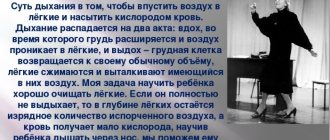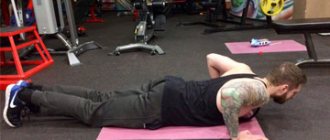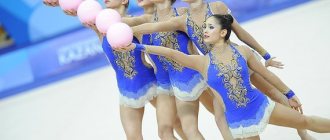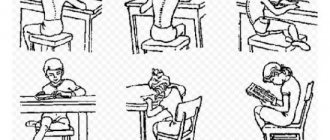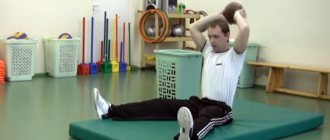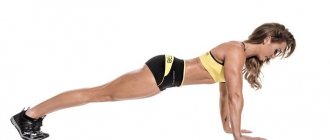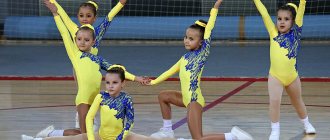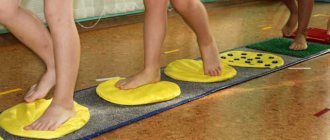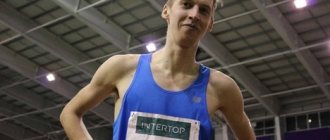Some parents consider exercise unnecessary (“why, there’s physical education at school!”), others don’t have an extra 15-20 minutes for their children, “because it’s work!”
And only a few mothers and fathers understand the importance of exercise for the child, and specifically get up half an hour early in the morning in order to have time to cheer up the child together and prepare the body for the school/work day with the help of effective exercises for children. If your children sleep in class and are constantly shirking physical education lessons, this instruction is for you!
When is the best time for a younger student to do exercises? How to prepare for gymnastics?
Man by nature must move a lot. It’s not for nothing that they say that movement is life. The less a child moves, spending all his free time near the TV and sitting at the computer, the more health problems he gets.
Children's specialists are sounding the alarm and reminding parents that children's bodies should be actively moving at least 10 hours a week, and for younger schoolchildren this minimum increases to 3 hours a day. Moreover, it is desirable that this happens in the fresh air.
Naturally, parents have too little time, but still dedicating 20 minutes in the morning and 20 minutes in the evening for exercise is not that difficult.
What types of gymnastics are suitable for children?
To teach a child to lead an active lifestyle, it is enough to choose a sport that requires mobility: football, swimming, badminton, roller skating and skating. But for weight loss in children, gymnastics is ideal, aimed at using all muscle groups. Children under 14 years of age are not recommended to attend gyms and professional sports clubs, because these activities place excessive stress on the child’s body. Therefore, regular gymnastics promotes effective weight loss and prepares the child for further activities.
Simple exercises can be performed without a trainer and at home.
You can set aside any time for gymnastics and select the intensity. One of the simplest types of gymnastics for weight loss is daily exercises. In the morning it raises the tone of the body, and during the day it improves well-being. In order for gymnastics to bring pleasure and results, you should adhere to clear rules:
- Regularity and gradual training is the surest path to success. Only daily exercise will help you lose weight;
- Moderate physical activity that stimulates energy expenditure;
- Short breaks between exercises, fast pace of classes;
- The training takes place one and a half hours after and before meals;
- Pay attention to cardio training, do not overload the child with strength exercises. Cardio exercise allows you to keep your heart rate in the fat burning zone;
- A well-thought-out set of exercises that includes different muscle groups.
How to prepare a child for exercise?
Of course, it’s difficult to get a child out of bed ahead of time, especially “for some kind of exercise.” This wonderful habit must be instilled gradually.
As you know, for a habit to become established, it takes about 15-30 days of regularly repeated actions. That is, after 2-3 weeks of such activities, your child will already be drawn to them.
Without attitude - nowhere. Therefore, the most important thing in forming this habit is to tune in and find motivation.
In addition, it is important that the child’s exercises change periodically (children at this age get tired of the same type of training too quickly).
And don’t forget to praise your child and encourage any physical activity in every possible way.
Sports exercises for children are all set to start
What will help a child grow up healthy? Of course, physical activity. It is not without reason that many pediatricians talk about the benefits of physical education for children.
Not all kids go to sports clubs, and not all parents hope to raise Olympic champions, but morning exercises and outdoor games will benefit every child, including yours.
But don’t overdo it with loads: a growing body requires a special approach.
The optimal duration of physical education for children under six years of age is 20-30 minutes. From time to time you need to take breaks between sports exercises (about half a minute) so that the baby can rest.
Important!
It is better to start and end classes with a light exercise - walking (on the spot or around the room). To prevent your child from getting bored, you can come up with funny rhymes and songs to accompany the exercises or use ready-made ones.
For example, Winnie the Pooh’s monologue “Where are we going with Piglet” is suitable for steps.
What other sports exercises for children can be included in morning exercises? Stretches (as we inhale, we raise our arms up and stretch up, as we exhale, we lower ourselves), bends forward, to the sides and back, swinging our arms and legs, squats, jumping rope. A good exercise to end a physical education session is to run around the room and then take leisurely steps to help the child calm down.
During physical education, you can use a gymnastic stick (you can do turns and bends with it), a jump rope (exercises with a jump rope for children are not only jumping, but also stretching), and a ball.
At first glance, there is nothing special about these exercises, but they are very useful for the child. Physical activity in children promotes muscle development, strengthens the cardiovascular system, develops correct posture, and improves coordination of movements.
Do not turn physical education classes into a competition or a fight for records: the child should do it with pleasure, without fear of punishment for an incorrectly performed exercise.
Cheerful music will help children add a good mood while performing sports exercises, but the main condition for proper exercise is, of course, the conscientious (yes, don’t shirk!) participation of adults. Exercising together will be both more fun and useful. By the way, this applies not only to exercises, but also to outdoor games.
If you are ready to take part in the same tag or can show how to jump rope correctly, children will be more enthusiastic about such fun.
A valid reason for temporarily canceling exercise and reducing physical activity is the child’s illness: you need to wait until the baby regains strength.
Advice!
It is usually recommended to return to physical education approximately two weeks after recovery, but you should focus on the child’s well-being.
If your illness is serious, consult your doctor before starting exercise.
During the day, have physical exercise sessions from time to time. They can include stretching, turning the head, and various exercises for the fingers will also be beneficial (invite the child to depict a kitten with sharp claws, a tree with leaves fluttering in the wind, folding his palms like a bird or a butterfly).
If you want your child to engage not only in physical education, but also in sports, then you will probably want to enroll him in some section.
Children five to six years old already have quite a large choice: they are allowed swimming, rhythmic gymnastics, team sports (football, volleyball, basketball, hockey), tennis and table tennis, dancing, figure skating.
So, here are 15 exercises for younger students:
The first 5 exercises are to warm up the muscles. It is strictly forbidden to do complex exercises immediately after sleep.
- We take a deep breath and rise on our toes. We pull the handles up as high as possible, as if we are trying to reach the ceiling. We lower ourselves to the full foot and exhale. Number of approaches – 10.
- We tilt our head to the left, return to the starting position for a couple of seconds and then tilt our head to the right. Next, we make circular movements with our heads - to the right side, then to the left. Execution time – 2 minutes.
- Now shoulders and arms. We alternately raise one shoulder, then the other, then both at once. Next, we swing our hands upward - in turn, now with our left hand, now with our right hand. Then make circular movements with your arms, as when swimming – first breaststroke, then crawl. We try to do the exercises as slowly as possible.
- We rest our hands on our sides and bend – left, right, then forward and backward. 5 times - in each direction.
- We walk in place for 2-3 minutes, raising our knees as high as possible. Next, we jump 5 times on the left leg, then 5 times on the right leg, then 5 times on both, and then jump with a 180-degree turn.
- We stretch our arms forward, interlock our fingers and stretch forward – as far as possible. Then, without losing the lock, we lower our hands down and try to reach the floor with our palms. Well, we finish the exercise by trying to reach the ceiling with our clasped palms.
- We do squats. Conditions: keep your back straight, legs shoulder-width apart, hands can be clasped behind your head or extended forward. The number of repetitions is 10-15.
- We do push-ups. Boys, of course, do push-ups from the floor, but for girls the task can be simplified - you can do push-ups from a chair or sofa. The number to repeat is from 3-5.
- Boat. We lie down on our tummy, stretch our arms forward and slightly up (lift up the bow of the boat), and also put our legs together, lifting up the “stern of the boat.” We bend the back as hard as possible. Execution time – 2-3 minutes.
- Bridge. We lie down on the floor (children who know how to lower themselves onto the bridge from a standing position, lower themselves straight from it), rest their feet and palms on the floor and, straightening their arms and legs, bend their back in an arc. Execution time – 2-3 minutes.
- We sit on the floor and spread our legs to the sides. We alternately reach out with our hands to the toes of our left foot, then to the toes of our right. It is important to touch your stomach with your leg so that your body lies with your leg - parallel to the floor.
- Bend your left leg at the knee and lift it up, clapping your hands under it. Then repeat with the right leg. Next, we raise the extended left leg as high as possible (at least 90 degrees relative to the floor) and clap our hands under it again. Repeat for the right leg.
- Martin. We spread our arms to the sides, move our left leg back and, slightly tilting our body forward, freeze in the swallow pose for 1-2 minutes. It is important that the body at this moment is parallel to the floor. Next, we repeat the exercise, changing the leg.
- We hold a regular ball between our knees, straighten our shoulders, and rest our hands on our waist. Now we slowly squat, keeping our back straight and the ball between our knees. The number of repetitions is 10-12.
- We rest our hands on the floor and “hover” above it in a “push-up” position. Now slowly, using our hands, we “go” to a vertical position. We rest a little in the “ostrich” pose and “stomp” our hands forward to the original position. We walk back and forth with our hands 10-12 times.
We finish the exercise with a simple exercise for relaxation: we stretch “at attention” while inhaling, tensing all the muscles – for 5-10 seconds. Then we sharply relax at the command “at ease”, exhaling. We repeat the exercise 3 times.
Why do you need charging?
A set of exercises called exercises is carried out with children from birth and is recommended for use throughout the entire period of growing up. Aimed at maintaining a high level of activity, physical development and stimulation of metabolic processes, it is carried out once or twice a day after sleep.
Regular use of exercises has many positive aspects. In particular, the morning warm-up complex:
- Strengthens the muscular system. With the help of specially selected exercises, it is easy to train the required muscle group;
- Increases vitality. Nothing invigorates you in the morning like a fun motor game;
- Improves appetite;
- Activates the work of all organs, especially the respiratory and cardiovascular systems;
- Allows you to form and maintain correct posture;
- Develops coordination;
- Develops endurance and discipline;
- Increases durability;
- Uplifting;
- It calms excitable children, and activates slow ones.
Simple, understandable, enjoyable exercises for the child allow you to start the day in a good mood, prepare for an active pastime, and develop the correct daily routine.
Features of the morning warm-up complex for preschool children
To get the maximum benefit from morning exercises, you must follow some recommendations based on many years of experience as educators, pediatricians and physiologists. The rules are very simple, but require regular implementation.
Time spending
The duration of morning exercises depends on the age of the child. For a newborn and baby, exercise consists of massage and exercises and lasts about 15 minutes.
Children over one year old who can walk can perform the gymnastics routine independently.
- For children 1-2 years old, the duration of one lesson should be about 5 minutes,
- for 3-4 years – 5-8 minutes,
- 5-6 years – 8-10 minutes,
- 7-10 years – 10-15 minutes.
Cloth
You should carefully consider the choice of clothes and shoes for classes. We recommend comfortable wardrobe items made of cotton fabric that do not restrict movement. It is not allowed to have large seams, buttons or other objects that can rub or create discomfort during active movement or performing exercises while lying on your back or stomach.
At home, you don’t have to wear shoes when charging, but it is advisable to wear socks on your feet.
Conditions
A home set of exercises must be carried out in a thoroughly ventilated area. For additional hardening of the body, it is good if the air is a little cool (about 18 degrees).
It is advisable to offer exercises before meals or 40 minutes after meals.
Carefully inspect the exercise area. Remove all unnecessary items and secure corners or moving parts. It is most convenient if there is enough space in the room where the charging is carried out for a short jog.
Form of conduct
Preschool children enjoy completing tasks using game elements. It’s good if morning exercises have a plot (visiting a bear or bunny; imitation of animals and plants). It is worth paying close attention to the name of the exercises presented to the toddler. Figurative, rich speech explaining the necessary actions will help the child remain interested in such pastime for a long time.
Additional items
If you decide to use additional equipment in the complex (ball, fitball, jump rope), then prepare the selected items in advance. There is no need to interrupt classes for a long search for the necessary equipment.
Pace and order
To benefit from morning exercises you need to:
- Regulate the speed of the exercises, suggesting that you perform them slowly at first, then speed up, reach the fastest version of the exercise, then slowly reduce the speed and stop. Preschool children are not recommended to stop abruptly when performing fast exercises;
- The lesson plan should be built as the tasks become more complex. The first thing you need to do is warm up. After warming up, offer to perform the exercises of the main complex. You should complete the exercise with a calm step in place and self-massage;
- Try to focus not on the number of elements completed, but on the quality of execution. If you asked your baby to walk with his knees high, then it is better to take 5 correct high steps than 25 fast and not high ones.
Baby's mood
Exercise is an activity that brings pleasure and joy. It should be feasible and pleasant for the little one. You should not force or overstrain your little athlete. If he doesn't feel well or gets up in a bad mood, it may be better to postpone the exercises and do them later. It’s good to captivate the baby by your own example.
Where to look for this motivation, and how to entice a child to exercise so that the child enjoys it?
- The main rule is to do exercises all together! Well, if dad categorically refuses, then mom should definitely participate in this process.
- We turn on upbeat and cheerful music. Doing exercises in silence is boring even for an adult. Let the child choose the music!
- We are looking for an incentive in each specific case. For example, an incentive for a girl can be a beautiful, toned figure that everyone will envy, and an incentive for a boy can be muscle definition that he can be proud of. Losing weight if the child is overweight will be no less of an incentive.
- We are looking for those we can imitate. We do not create idols (!), but look for a role model. Naturally, we are looking for him not among bloggers and bloggers with beautiful bodies and emptiness in their heads, but among athletes or heroes of films/movies that the child loves.
- Exercise is needed to become stronger. And you need to be strong (strong) to protect your younger brother (sister).
- In addition to 5 exercises to warm up the muscles, you need to choose another 5-7 exercises for direct exercise. No more is needed for this age, and the workout itself should take no more than 20 minutes (twice a day). But it is important to regularly change the set of exercises so that the child does not get bored! Therefore, immediately make a large list of exercises, from which you will pull out 5-7 new ones every 2-3 days.
- We talk with the child more often about health : why exercise is so important, what it gives, what happens to the body without physical activity, and so on. We are looking for thematic films and cartoons, which we watch, of course, with the child. We often watch films in which young athletes achieve success - often these films become powerful motivators for a child to enter the world of sports.
- Set up a sports corner for your child in his room . Let him have personal parallel bars and rings, a Swedish barre, a fitball, a horizontal bar, children's dumbbells and other equipment. As a reward for each month of training, make it a trip to a trampoline center, play climbing, or another sports attraction. The best home sports complexes for children
- Use his own preferences to attract your child to exercise . For example, if a child loves a ball, consider a set of exercises with the ball. He loves parallel bars - do exercises on the children's playground. Etc.
How the training goes
Children's fitness for kids involves active exercises in a playful way. Thus, children dance and perform simple physical exercises to specially selected songs from cartoons or classical music.
Modern fitness centers offer many options for children's training. Here are the most popular ones:
- Logo aerobics. The essence of this direction is the combination of physical exercises with the recitation of poems and unrhymed phrases. The main goal of the classes is to develop coordination.
- Step by step. At such trainings, instructors teach children to walk correctly, develop the ability to maintain body balance, and develop fine motor skills.
- Fit Ball. Active physical exercises using large inflatable balls. Classes help develop the child’s musculoskeletal system.
- Yoga for children. Training has a positive effect not only on physical development, but also on the emotional sphere of children.
- Children's training in the pool. Swimming with elements of aqua aerobics. An excellent choice for hyperactive guys.
Video: Fun exercises for a child
Remember that it is impossible to force a child to exercise like hard labor. It is important that he himself wants to work with you. Therefore, first of all, we demonstrate the importance of charging with our own example.
Children at this age are already excellent at thinking and analyzing, and if you are constantly lying on the sofa, growing a belly, then you simply will not be able to force your child to study - personal example is more effective than all other methods.
The site Colady.ru thanks you for your attention to the article - we hope that it was useful to you. Please share your feedback and tips with our readers!

